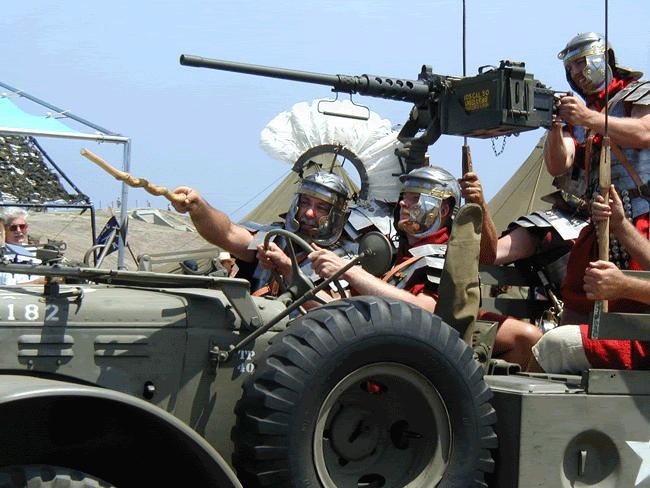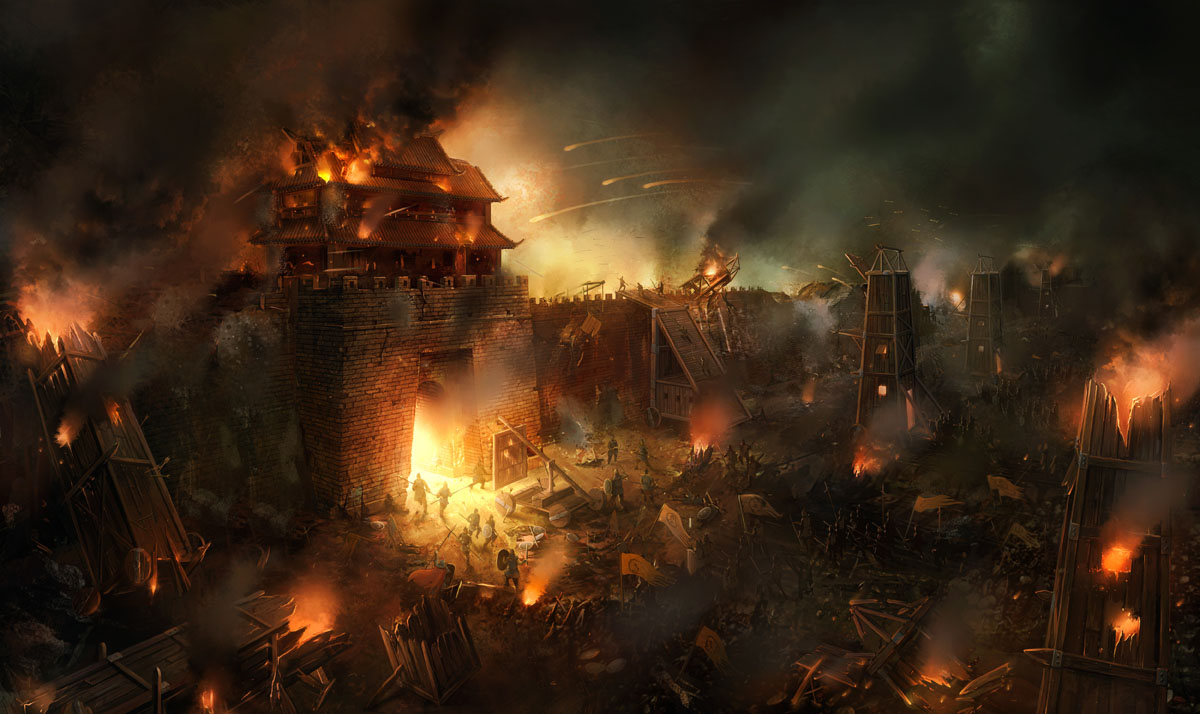After (and during) Overshoot there is likely to appear fundamental differences in the military equipment and tactics, due to fundamental differences in technology, between various countries, continents (more so than currently) and even within single militaries. It will however be different than when Europe almost conquered the world because most militaries will be aware of each others capabilities and it won't be the same sort of mismatch (especially in terms of military thought and organization/motivation) nor as big technological differences (probably) that was seen during the era of colonization, (importantly social technologies, such as Nationalism, will be fairly evenly spread throughout the world). I should also stress that it isn't similar to the situations faced by say Rome and most empires, that difference was normally either one of organization or of a slight technological edge combined with an efficient military. Rome in the beginning had either equal or inferior technology than its opponents, the Celts were superior iron workers, while the Carthaginian soldiers were roughly as effective as the Roman legions they faced. Parthia had better cavalry, while Rome had better infantry and so the terrain decided the border for them. What made the Roman armies superior was a combination of strategy (it was actually an extremely cautious one), training and organization (their communication system was far superior to the barbarians for example). The difference here is on the level of different fundamental technologies, such as in metallurgy, precise machining and so on, rather than the soldiers having different products of the same underlying technology (such as the wide variety of assault rifles currently available).
 An example of the differences could be one area which cannot mass produce automatics and so either imports them from an area which can mass produce automatics or has small scale artisanal production with the majority of the military armed with bolt action rifles. Or a specific area cannot create decent guns and so uses bows or arbalests (advanced crossbows) and neighbours a region which can produce non-automatic rifles. That isn't as lopsided as it sounds, at one point it was seriously considered to replace WW1 era guns with longbows because a well trained long bowman has significant tactical advantages over a WW1 soldier. Logistics (it would have taken a lot of trees) and training ("to get a great longbow man, start with his grandfather", old saying) were the main problems with the idea, not the ineffectiveness of longbows. This sort of technological imbalance will most obviously affect ships, vehicles, aircraft and artillery, drastically affecting the tactical and strategic landscapes, infantry due to their ability to use terrain/cover the best and their low cost gear will likely be affected the least. These technological differences will exist because of fundamental differences in resources, social organization and supporting technology available across the world.
An example of the differences could be one area which cannot mass produce automatics and so either imports them from an area which can mass produce automatics or has small scale artisanal production with the majority of the military armed with bolt action rifles. Or a specific area cannot create decent guns and so uses bows or arbalests (advanced crossbows) and neighbours a region which can produce non-automatic rifles. That isn't as lopsided as it sounds, at one point it was seriously considered to replace WW1 era guns with longbows because a well trained long bowman has significant tactical advantages over a WW1 soldier. Logistics (it would have taken a lot of trees) and training ("to get a great longbow man, start with his grandfather", old saying) were the main problems with the idea, not the ineffectiveness of longbows. This sort of technological imbalance will most obviously affect ships, vehicles, aircraft and artillery, drastically affecting the tactical and strategic landscapes, infantry due to their ability to use terrain/cover the best and their low cost gear will likely be affected the least. These technological differences will exist because of fundamental differences in resources, social organization and supporting technology available across the world.These differences will also affect each branch differently. The air forces will likely be the most affected and could quite easily disappear from large areas, or return to pre-WW1 forms with recon balloons. Dogfights in WW1 were often over these balloons and with airships likely to have a greater role, this role of aircraft could see a resurgence albiet one that is more mobile (like mortal engines). Where they stay, they'll probably be reduced to attachments to the army or navy, rather than as a separate organization and be focused on recon, emergency supplies and critical strikes rather than today's use of them for massed bombing and close air support. If airships appear then they'll be mostly transport and recon, or even mobile airbases (unlikely but possible). More advanced air forces will have a major advantage over more primitive air forces, so much that significantly inferior ones could only be used opportunistically or by buying advanced planes from other states, though it should be noted that if the tech gap is small then enough numbers on the inferior side could outweigh that advantage somewhat. Fueling them will be the major challenge and chances are that if they're not needed, they won't be used simply to preserve fuel and only major wars or battles will see them. This would mean that overall pilot quality would be much lower due to less training flights, though it is possible that many militaries would have several squadrons of elite pilots who train regularly. This also means that most skirmishes or battles would not see aircraft.
 |
| A Galleasse |
The army is different from both the navy and air force in that while technological differences matter, they aren't nearly as decisive. Think of the Vietnam war, where the technologically inferior Vietcong defeated the technologically superior USA. To quote Napoleon (and he knew what he was talking about)“In war, the moral is to the material as three is to one.”, other factors like moral, discipline, organization, leadership, numbers and such have a far greater impact than technology on its own. Generally though, the armies that have access to the best technology also happen to have good morale, training, leadership and such (That this was not true in Vietnam was one of the reasons for a US defeat, and something similar is playing out in Afghanistan). When these qualities are lacking, no amount of gadgets or equipment can make up for them. This is why Pakistan's and India's armies are walking farces (compared to western and east Asian armies at least), along with many African armies (how many rebels does it take to beat them again). As Machiavelli said, "I maintain, therefore, that it is not gold, as is vulgarly supposed, that is the sinews of war, but good soldiers".

Technology however has an effect on what qualities are important and how they manifest. Courage is a good example, is it courageous to hold your fire until the right moment, fight in single combat or not leave the formation. The answer depends on what warfare type and weapons are in play (respectively, Hezbollah, Tribal and Spartan). Some values are suppressed or favored, initiative was vital for the early successes of Germany during WW2 but when fighting in large blocks with muskets its not needed and can be counter-productive in low level officers. Additionally armies are likely to have a wide variety of technology, elite squads with automatic weapons, massed conscripts with rifles, militia with bows or arbalasts fighting alongside each other. Or velomobile towed artillery or machine guns working alongside their horse drawn cousins. This will by its nature make militaries both more complex and more resilient, except if its badly managed in which case they would be very brittle. The military cultures generated by these differences could vary by a significant amount, even inside the same military, which would be a source of friction (especially if that means there are several military organizations of varying sizes and capabilities like in Iran).
Terrain also has a massive impact on the choice of technologies and how effective they are. Its not an accident that Europe throughout history fielded primarily infantry armies while in the middle-east cavalry was far more common (in fact knights were invented in the Middle East). The border between Parthia and Rome was formed around this, on Parthia's side it was flat and favored cavalry, while on the Roman side it was hilly and favored infantry. No horse army has conquered Europe (despite coming close) because of its terrain and in the future terrain will play a much larger role in the technology chosen than it does now. So some areas won't have certain vehicles, simply because the terrain disadvantages them (heavy tanks are likely to see this often, especially due to their high fuel use). Logistics also plays into it, both from what support vehicles can be used and how difficult transport is. Since a lot of advancements happened in the Napoleonic ear, such as improved carts, its not likely for military logistics to degrade hugely,but degrade they will. Besides ancient empires fielded armies of significant size before, its just that gun based armies require far more support than sword based armies.
This greatly affects strategy, tactics and training. What works against one technology suite doesn't against another. So imagine a state which has two technologically different neighbours and how their military copes (say a small, highly mechanized force and a large bolt action rifle and artillery force). Or an army which is used to fighting one technological suite suddenly fighting a different one. How about mercenaries that work across continents (like the Swiss did), how are they supplied and how do they deal with the varying technologies.
Siege warfare will no doubt be interesting. One of the more important attributes of the defender is storage of water and food, its generally easier to wait it out than reduce the defenses. So refrigeration, canning and the other new preservation tricks would make prepared positions incredible hard to wait out. And thanks to material science, incredibly hard walls can be made and then theres the thousands of years of experience of building fortifications. On the other hand, the science of breaking walls down has advanced and a large range of tricks is likely to remain (additionally the very existence of long range artillery is an incentive to not wall cities). So, while siege warfare will certainly have the same fundamentals, it will probably be unique and differ from past and modern examples.


Great essay only let down by repeated crashing grammatical errors on there /their / they're which undermine the credibility it deserves.
ReplyDeleteand chances are that if their not needed - they’re
if that means their are several military organizations - there
their are a couple of other tricks - there
and then theirs the thousands - there’s
cheers
Mustard
Fixed it.
ReplyDeleteThanks, I didn't notice those. Gotten too used to word's grammar check. Blogger's isn't nearly as good.
The Romans in the jeep are from Legio IX Hispana, a Roman reenactment club out of San Diego, CA. Photo taken by Maryann Sullivan at Old Fort MacArthur Days in San Pedro.
ReplyDelete